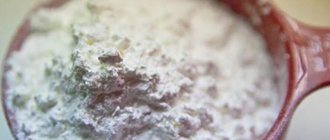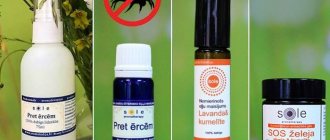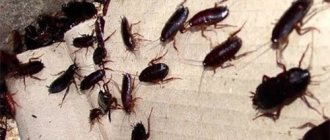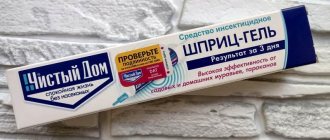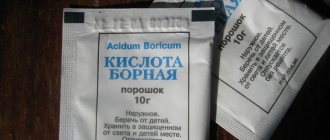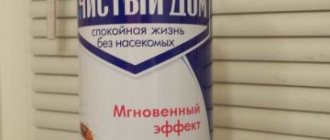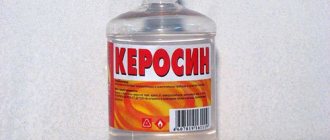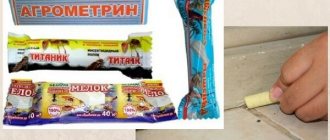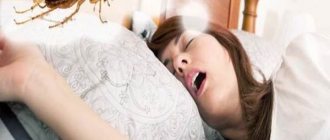Dust is an insecticide that helps to quickly get rid of cockroaches in the apartment. Over time, its effectiveness has also been proven against blood-sucking parasites such as bedbugs. The product is accessible and easy to use, but if used incorrectly it can be harmful to health.
To avoid this, you need to read the instructions and rules for using this product.
- 5.1 How does it affect ants?
What is dust?
The drug is a light-colored crystalline powder that is practically odorless. Sold in sealed bags from 50 g and above.
The dust contains several active components.
Among them:
- cypermethrin:
- esfenvalerate
- malathion;
- tetramethrin;
- boric acid.
Also, in addition to the main active components, the dust powder contains about 10% pineronyl butoxide. This component provides a prolonged protective effect of this product. Depending on the type of dust, its composition may vary.
Boric acid
The toxic powder also contains additional components: fragrances, talc. They maintain the powdery texture of the product, prevent caking during storage and mask the unpleasant odor of active substances.
Dust production
Pesticides can be powdered more or less easily depending on their properties.
The most easily crushed substances are those with a well-formed crystalline structure, which have a fairly high fragility and low ductility. As a rule, technical products containing oily impurities are more difficult to grind. When grinding in ball mills, such products clump and form large aggregates that stick to the walls of the mill. The inert filler prevents the preparation from clumping, both during the grinding process and during storage of the prepared powder. The amount of filler added depends on its sorption capacity; The higher the sorption capacity of the filler, the less of it is required to obtain a good grinding product.
When grinding in ball mills and other similar units, as a result of impacts of the balls, a slight increase in temperature occurs, as a result of which partial melting of the pesticide is possible. Therefore, when grinding in ball mills, a slightly larger amount of filler should be added, and grinding should be carried out at the lowest possible temperature. Ball mills with air separation are most often used. Sometimes grinding is carried out in two stages: first, a concentrated powder is prepared (grinding on runners, in a ball mill or other type of units), which is then diluted with filler and additionally ground in a ball mill. Good quality dusts are obtained when using an air-jet mill, but the cost of the product in this case increases significantly due to the high energy consumption.
Of interest is the method of producing dusts by mixing molten pesticide with ground filler. Several modifications of this method are known for the preparation of low-melting pesticide dusts with high plasticity. Dusts from liquid organophosphorus pesticides are easily obtained in this way. However, when preparing organophosphorus pesticide dusts, it is necessary to strictly approach the choice of filler. It should be kept in mind that some excipients promote the isomerization of thiophosphates and dithiophosphates into more toxic compounds. This, in particular, was discovered for karbofos. To prepare organophosphorus pesticide dusts, you should not use alkaline fillers that hydrolyze the pesticide.
The basic technological flow diagram for the production of dusts is shown in the figure.
If the pesticide is a liquid, it is injected into the mixer using special nozzles. In this case, it is recommended to use crushed filler, which makes it possible to eliminate the grinding stage in the production of dust and limit ourselves to two-stage mixing.
How does modern dust differ from Soviet dust?
The modern insecticide is fundamentally different from the Soviet Union drug in its composition. Previously, dust powder was used, the main component of which was dichlorodiphenyltrichloromethylmethane. Subsequently, it was proven that this substance gradually accumulates in the human body, which causes the development of cardiovascular diseases and atypical pneumonia. Based on this, the use of dust in buildings and agriculture was prohibited.
Modern analogues of the drug do not contain dichlorodiphenyltrichloromethylmethane. Nowadays, dust is actively used by sanitary and environmental services for disinfection and disinfestation. And using the product at home involves minimal risks, which can be avoided by strictly following the instructions.
General information about dust
Poisoning by any toxin is of a domestic or professional nature.
The second situation arises when toxic substances are used in crop production, agriculture or production. Household poisoning is characterized by the ingestion of toxic substances into the body due to violation of the rules for using pesticides or non-compliance with safety rules. Dust (DDT, dichlorophenyltrichloromethylmethane) is a common pesticide widely used in agriculture in the past. Due to its high level of toxicity it was banned. Currently used in everyday life to combat bedbugs, cockroaches and other insects.
Symptoms of dust poisoning are associated with a negative effect on neurons. The substance easily passes through mucous membranes and is absorbed into the body, which made it highly effective in the fight against insects.
Find out what toxic poisoning is and how you can eliminate its consequences.
Read about strychnine poisoning: characteristic signs, help, treatment.
Kinds
There are different types of dust on sale to kill cockroaches and bedbugs. They differ in composition and principle of action.
Popular types:
- Chinese dust. The powder is sold in plastic bottles. You can only purchase it online. According to many consumers, the product quickly destroys pests and parasites in the apartment. In terms of composition, it is practically no different from Russian drugs.
- Double Available in convenient bags equipped with a sprayer. A broad-spectrum drug. Its use against ants, cockroaches, bedbugs, flies and fleas is justified.
- Tornado. A universal drug that is effective against all crawling insects. Produced in 150 g bags, which is enough to treat a room of 100 square meters. m. Contains cypermethrin and boric acid.
- Clean house. It is available not only in powder form, but also in suspension form. Contains two active components: permethrin, malathion. Effective against cockroaches, ants, fleas, bedbugs. Retains protective properties even with sudden temperature changes.
- Acarytox. Recommended for use in large spaces. The drug is sold in 1 kg packaging. The active substance is alphacypermethrin with a concentration of 5%.
- Dust Absolute. The active ingredients are fenthion and deltamethrin. Available in 100 g bags and 70 g plastic duster bottles. The structure of the drug is designed to reduce dust and increase adhesion to vertical surfaces.
The drug itself
Useful tips
Places that need to be treated with dust
Despite the fact that cockroaches most often live in the kitchen or bathroom, the entire apartment needs to be treated with dust. Otherwise, several individuals will manage to hide in an untreated room and survive the treatment safely. We must not forget about the paths by which insects move; there it is necessary to apply the drug especially generously.
Places where cockroaches and bedbugs can live
The dust is not dangerous for the human body or pets, but it is better to leave the room during treatment. In hard-to-reach places, the product can be left on for several weeks, while surfaces with which people constantly come into contact should be thoroughly rinsed the next day.
Produced in Russia, it is a popular, inexpensive remedy against cockroaches (cost ranges from 10-15 rubles), recommended for treating residential premises. Despite the high effectiveness of the drug, it is better to use it in combination with other drugs.
Cockroaches quickly get used to the components of the dust, which makes it difficult to destroy them in the future (they will then have to be poisoned with a gel or spray).
It will be useful to know that “Clean House” is effective not only against cockroaches. They can poison bedbugs, ants, and other domestic insects. This property of the drug is important for those who do not have time for numerous treatments; often one is enough for all pests to completely disappear from the apartment.
Operating principle
Before using the dust, you need to carefully study the instructions for the product and the principle of its action. This directly depends on the active components included in the composition. Dust can poison pests, and it also helps get rid of parasites. In this case, the treatment can be carried out dry or diluted with water.
Nervous agent
This effect of the dust is due to the presence of pyrethroids in its composition. Upon direct contact, the active component blocks the transmission of nerve impulses, which leads to paralysis of the insect. And then the pest dies, without access to water and food.
Intestinal
This species also causes paralysis and death of the insect, but only when the active component enters its digestive tract. In this case, it is recommended to combine the use of dust with food products so that insects have a desire to eat the toxic bait. The intestinal effect of the drug is ensured by the presence of borax or boric acid in it.
Causing dehydration
Dust can also be used as a dehydrating agent. When the drug comes into contact with an insect’s body, it activates the absorption of moisture from its body, which ultimately leads to death. This principle of action of the drug is due to the presence of diatomite in its composition.
How to use dusts
To exterminate parasites, powders are scattered where they accumulate and crawl. These are places near baseboards, under sinks, near the toilet and trash can. In apartments the dust is spread at night. In the morning, the powder along with the dead cockroaches is swept up with a broom so that it does not fall on children or animals. In non-residential premises the powder is left for a long time. Dust works for 1.5-2 months.
Bait stations made from cardboard boxes and cigarette packs are also installed in apartments. Holes are cut in them and powder is poured in. They also put bait with a strong smell there: sausage, apple, bread with vegetable oil.
When using dusts, make sure that cockroaches do not have access to sources of water. If a poisoned insect gets drunk, the effect of insecticides will be significantly reduced, and the parasites that have received a small dose of poison will not die. The absence of water is especially important when processing with boric acid and preparations with diatomaceous earth. To do this, close the taps tightly, wipe away any drops on the sink, and remove unfinished tea.
When handling powders, observe the following safety precautions:
- They work in overalls with sleeves, respirators or a gauze bandage.
- When the effect of the powder ends, the room is ventilated and washed.
- In apartments where allergy sufferers live, powders containing toxic chemicals are not used. To exterminate cockroaches, boric acid and Ecokiller dust are used.
Application procedure against cockroaches and bedbugs
When using cockroach dust, you must first prepare the room. To do this, place all products in sealed plastic containers. Then you should move the furniture to open access to the places of movement and localization of cockroaches. And at the end, carry out wet cleaning.
Depending on the type of dust, its method of application may differ. Agents that have a nerve-paralytic and dehydrating effect on cockroaches should be poured onto sheets of paper and placed under the stove, refrigerator, kitchen unit, washing machine, sink and near the trash can.
Example of places where dust can be poured
The use of intestinal cockroach dust is possible when combined with products. To do this, use sugar or boiled egg yolks. After preparing the baits, they need to be placed in places where pests accumulate.
According to the instructions for using the dust, it is better to use a solution for bedbugs. To do this, you need to dilute the powder in warm water at the rate of 10 g per 1 liter. It is necessary to process seams, folds and joints of individual elements on beds, armchairs, and sofas. It is also recommended to spray the back walls of cabinets, pictures, and peeled wallpaper.
How does it affect ants?
Treatment with ant dust helps to cope with the problem in a short period of time. Even a small amount of toxic powder has a detrimental effect on insects. To destroy, you need to scatter the product along the routes of movement of ants.
Does it get rid of fleas?
Dust has a detrimental effect on fleas, as well as on other parasites. For processing you need to use a solution. To solve the problem, you need to spray the floor and carpets with it once.
Methods of using dust to get rid of cockroaches
The procedure for using cockroach dust includes 3 stages: preparing the room, observing safety precautions, and correctly applying the product using the chosen method. The methods of using the powder are very diverse.
Preparation
Before using dust in an apartment:
- send family members and pets to stay with relatives for 1-2 days;
- remove carpets, paintings and indoor plants from the room;
- Pack children's things and toys in plastic bags and hide them in the closet;
- remove all food products from public access by placing them in airtight containers or the refrigerator;
- get rid of litter and dust in the apartment by wiping all surfaces and the floor with a damp cloth;
- move furniture if necessary.
It is also recommended to remove tablecloths from tables, curtains and curtains from windows.
Application of dry powder
In the classical way, dust is used in dry form. There is no need to pre-prepare the composition or bait. After preparing the area and following safety precautions, apply a thin layer of powder to surfaces and furniture that cockroaches may come into contact with. Pay extreme attention to the paths to the trash can and sink, as well as to those places where the greatest pest activity has been observed.
Application of liquid dust
To prepare the solution, pour 10 grams of dust with 10 liters of water. Pour the resulting mixture into a container with a spray bottle. Spray the substance on all surfaces where cockroaches might crawl.
With the help of a water jet, you can reach inaccessible places and pour the poison into places where powder cannot be poured, into cracks or small holes in the walls.
Cockroach dust with egg
Cockroaches are sensitive to the smell of food, especially the aroma of egg yolk. Use this trick and prepare poisonous dust-based baits for pests.
Hard boil two eggs and separate the yolks. Mix the yolks with 10 g of dust. Make balls from the resulting mass and place them in insect habitats. Carry out the procedure observing the safety rules.
The cockroach will definitely eat the fragrant bait with poison, thereby dooming itself to inevitable death.
Dust as part of other mixtures
Most powders are based on an intestinal effect on the pest, so your task is to ensure that the drug gets into the cockroach’s esophagus. This can be achieved by preparing aromatic baits.
Proven bait recipes:
- Mix 1 tbsp. spoon of dust with 1 boiled potato and egg yolk. Mix well and roll the mixture into small balls. Place bait in cockroach habitats and wait for the results.
- Prepare a dough from 100 g of dust, 15 g of vanilla sugar, 30 g of powdered sugar and 15 g of starch. Roll up bait balls and place them in areas where pests are active.
- To attract insects, add flour and powdered sugar to the dust powder in equal proportions. Stir and distribute the mixture indoors.
To make cleaning easier after expelling cockroaches, place baits first on paper and only then in the right places.
Which areas should I treat and how long should I keep the drug on?
The application of the drug is simple - arm yourself with a brush or sponge and apply a thin layer of powder to all surfaces where contact with cockroaches is possible. These places include;
- baseboards;
- the floor and walls behind the refrigerator, gas stove or kitchen cabinets;
- space under the sink;
- the area where the trash can usually stands;
- water and sewer risers;
- heating pipes and radiators;
- doors;
- window sills;
- ventilation ducts;
- walls and seams of furniture both from the outside and from the inside;
- reverse sides of carpets and rugs.
Depending on the degree of contamination of the room, keep the powder on the surface for at least a day. If cockroaches are very active in the apartment, leave the product on for 6–7 days. Before leaving home, close all vents and windows.
How to properly clean a room?
When the exposure time in the apartment is over, return and remove the remaining insecticide.
Proper cleaning of a room is carried out in several stages.
- Open the windows and ventilate the rooms.
- Prepare a cleaning solution based on soap, soda, dry mustard or lemon juice.
- Wipe all treated surfaces thoroughly.
- Places that have not been exposed to dust should also be washed.
- The powder can be left in inaccessible areas, for example, in ventilation and under baseboards, as long as pets and children do not get there.
Carry out the procedure wearing rubber gloves.
If the dust left behind smells unpleasant or makes you feel worse, immediately re-clean and ventilate the apartment.
Safety precautions when working with dusts
When treating a surface with dust, it is important that the product does not get on the skin, mucous membranes, or into the digestive or respiratory system.
Security measures:
- organize access to fresh air into the room, so open windows or vents during treatment;
- Wear clothes that fit tightly to your body and completely cover your arms and legs;
- put your hands in rubber gloves;
- Put a respirator or a cotton-gauze bandage on your face.
After the procedure, carefully remove clothing and wash immediately; discard the glove and mask immediately.
Is dust dangerous for humans?
Manufacturers indicate that the drug is moderately toxic and safe for humans. However, this does not mean that you can neglect safety rules during processing or come into contact with the substance. In case of contact with the skin or mucous membranes, allergic reactions may occur. If you inhale vapors or swallow the drug, your body may be poisoned.
Can dust harm children and pets?
Dust can cause intoxication if it enters the body of a child or animal. Do not allow them to be nearby during the procedure. There is no guarantee that the product will not enter their digestive tract. Also make sure that children or animals do not reach the bait or powder scattered for further exposure.
What to do in case of poisoning?
If the precautions are not followed fully, the body may be poisoned. You have been poisoned if you have:
- cough;
- suffocation;
- headache;
- dizziness;
- nausea;
- fever;
- general weakness of the body.
If at least one of the symptoms appears, immediately leave the room being treated and go outside. If signs of poisoning do not go away within 1.5-2 hours, consult a doctor immediately.
In addition to simple poisoning, cumulative intoxication is possible. It usually manifests itself due to the long-term influence of the substance on the body and can be noticed after the procedure.
Signs of cumulative intoxication:
- regular dizziness and headaches;
- disruption of the gastrointestinal tract;
- rapid fatigue of the body;
- pain in the esophagus, stomach or intestines.
If you notice these symptoms in yourself or your child, visit your doctor immediately. Carry out a thorough cleaning of the room, thoroughly washing the treated areas with soap or soda. For the next treatment, choose a less toxic product.
If the substance gets on the skin or mucous membranes, immediately rinse the affected area with running warm water. If discomfort does not go away within 2-2.5 hours, consult a doctor.
No matter what symptoms you visit a therapist, always take the product packaging with you. This way, the doctor, having studied the composition, will be able to understand what you were poisoned with and make a diagnosis faster.
Advantages and disadvantages
Dust is a time-tested remedy that helps quickly get rid of cockroaches, bedbugs and other annoying insects.
Main advantages:
- economical consumption;
- availability;
- quick results;
- is not addictive;
- destructive to adults and larvae;
- remains effective during storage and temperature changes;
- provides long-lasting protective effect.
Flaws:
- not effective in case of mass infection;
- does not destroy egg laying;
- can cause allergies.
What consumers say
Having entered the university, my friends and I lived in a dormitory. Just a couple of days later, we began to notice rashes on the skin, which were accompanied by severe itching and burning. At first we thought it was an allergy, but then we remembered that each of us has individual products, cosmetics and household chemicals from different manufacturers. Everyone was shocked!
No one had ever experienced this before. Then they found several black shells and some black dots on the window. I read online that these are signs of bedbugs. Our bites were the same as in the picture in the article. We quickly found a list of budget-friendly ways to kill bedbugs, dust was in first place. Before the couples, we bought a bag, without reading the instructions, sprinkled dust along the baseboards, and went to the couples. We returned home only in the evening, washed everything together and went to bed.
The bedbugs reappeared a few weeks later. I was very upset and decided to ask the seller why they were selling such an ineffective substance. The man asked to tell us in detail how we treated the room, and immediately pointed out the mistake. It turns out that it was necessary to carry out another treatment a week after the first. I returned home, carefully re-read the instructions, and my friends and I did everything correctly.
The result was truly stunning. Now, as a preventative measure, every month we sprinkle dust on the baseboards and the floor behind the cabinets to prevent parasites from having the slightest chance to settle in our room.
Angelina, 18 years old
While training to become a cook, I was sent to do an internship in a village public canteen. There was a very responsible manager who worked there and kept the dining room perfectly clean. When someone saw a bug in the kitchen, the manager decided to sanitize the entire room. As a new employee, I was tasked with processing the cabinets. They gave me some kind of powder to work with. I already began to imagine how I would be poisoned and suffer from the consequences for a very long time, and that even glasses and a respirator would not save me. I was very surprised when, upon opening the bag of the substance, I did not notice a pungent odor. I carefully completed my task, took off my protective equipment and even then did not feel even the slightest discomfort. The next day, the whole team cleaned the dining room well. When I returned to work two days later, there were no traces of pests. I'm glad I had this experience. And now I won’t be confused in such a situation.
Zinaida, student
When I was sent to another city, I rented a room in the cheapest hotel. People come here only to sleep; comfort did not play an important role for me. But later I noticed some red pimples on my arms. They were very itchy and painful. I got scared and went to a dermatologist. It turned out that these were bedbug bites. I had to leave home in two days, so I had already somehow survived two nights. But how upset I was when I found out that I had brought these parasites home. And we have two small children! I immediately went to the market. There I was advised to buy “Clean House” and use it only in accordance with the instructions. I decided not to risk it and did everything exactly according to the recommendations. There was no trace left of the bedbugs. Now, when asked whether dust helps against bedbugs, I answer a resounding “yes.”
Anatoly, 30 years old
